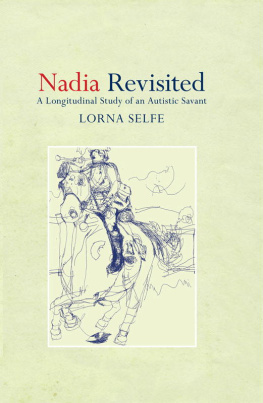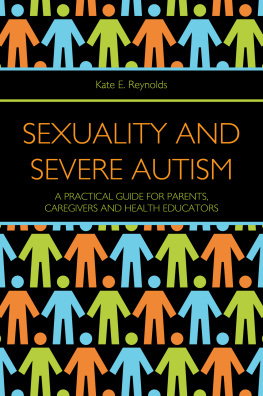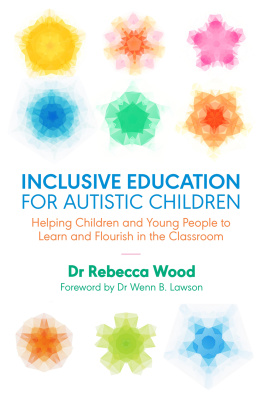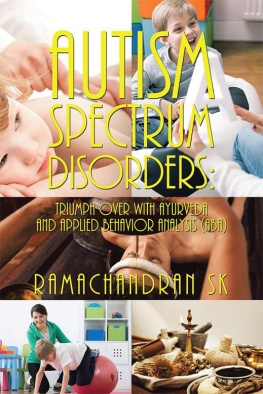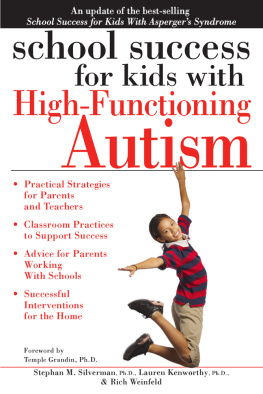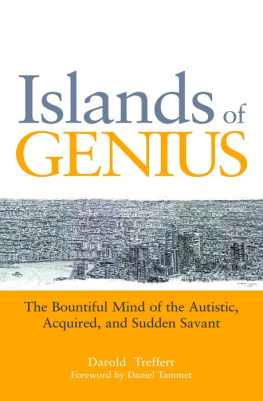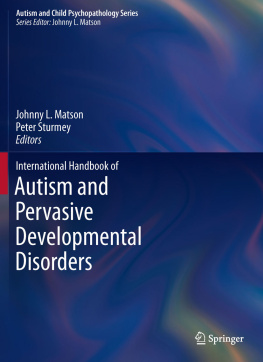Nadia Revisited
This book re-examines the case of Nadia, discovered as a child aged six, who had been drawing with phenomenal skill and visual realism from the age of three, despite having autism and severe learning difficulties. The original research was published in 1977 and caused great international interest. Nadia Revisited updates her story and reconsiders the theories that endeavour to explain her extraordinary talent.
As well as summarising the central issues from the original case study and presenting her remarkable drawings, the book explains Nadias subsequent development and present situation in light of the recent research on autistic spectrum disorders and representational drawing in children. The book also considers the phenomenon of savant syndrome, the condition in which those with autism or other learning disabilities have areas of unusual talent that contrast dramatically with their general functioning.
Lorna Selfe uses this single case study to discuss theories of developmental psychology and considers the possible links between prodigious talent and underlying neurological dysfunction. The book is especially valuable for students and teachers of developmental psychology and neuropsychology, education and special education, as well as art and art education. Parents of autistic children or those with related disorders, learning difficulties or special needs will also be interested in the discussions presented in this book.
Lorna Selfe is a child psychologist with extensive experience of working with children and families in Local Authority and NHS settings. She has published several books on various aspects of special needs. She was Principal Educational Psychologist for Herefordshire.
Nadia Revisited
A Longitudinal Study of an Autistic Savant
Lorna Selfe

First published 2011
by Psychology Press
27 Church Road, Hove, East Sussex BN3 2FA
Simultaneously published in the USA and Canada
by Psychology Press
711 Third Avenue, New York NY 10017
Psychology Press is an imprint of the Taylor & Francis Group, an Informa business
2011 Lorna Selfe
Lorna Selfe has asserted her moral right as author of this work in accordance with the Copyright, Designs and Patents Act 1988.
Every effort has been made to trace the copyright holders and obtain permission to reproduce material from other sources. Any omissions brought to our attention will be remedied in future editions or reprints.
All rights reserved. No part of this book may be reprinted or reproduced or utilised in any form or by any electronic, mechanical, or other means, now known or hereafter invented, including photocopying and recording, or in any information storage or retrieval system, without permission in writing from the publishers.
British Library Cataloguing in Publication Data
A catalogue record for this book is available from the British Library
Library of Congress Cataloging in Publication Data
Selfe, Lorna.
Nadia revisited : a longitudinal study of an autistic savant / Lorna Selfe.
p. cm.
Includes bibliographical references and index.
ISBN 978-1-84872-038-1 (hb)
1. Autism-Longitudinal studies. 2. Savant syndrome-Longitudinal studies. I. Title.
RC553.A88S45 2011
ISBN: 978-1-84872-038-1 (hbk)
ISBN: 978-0-203-82576-1 (ebk)
The book is dedicated to Paul, Jessie and Amy Also to John and Elizabeth Newson
Contents
Figures
Acknowledgements
I wish to acknowledge the help and encouragement that I received in this project from my family. I am also grateful to Frances Kelly, my agent and to the editorial team at Routledge, in particular, Tara Stebnicky and her colleagues and Annalisa Welch. The thorough guidance that they provided has been invaluable in completing the project. I also received helpful and positive responses from many holders of copyright throughout the world, who provided the necessary images. The archivists and curators of galleries and museums, especially in Hereford and Surrey, were most generous with their time in discussing the artwork that was available in their collections. I also wish to acknowledge the help provided by Mr Michael Phillips of the Bethlem Royal Hospital Archives and Museum Service in which the archive of Nadias work is held. I am grateful to many academics and professionals working in the field with whom I had valuable discussions. They include Dr Linda Pring, Margaret Oke, Peter Lane, and colleagues in the Powys Health Authority, together with some of the artists whose work appears in the book. Naturally, this project could not have proceeded without the full agreement of the team in NORSACA (Nottingham Regional Society for Autistic Children and Adults) who look after Nadia, with such care and dedication. The author royalties from the sale of this book will support this charity.
Introduction
Nadia over 30 years
This book is a longitudinal study of a remarkable individual. The story is in some ways a sad one but it is also a story of resilience and dedicated care. Nadia was a special, and possibly, uniquely gifted child. Commencing at the age of 3 years, she drew pictures of fairground horses with astonishing skill and realism. She bypassed all the usual rules for the development of drawing ability in children and by the age of 5 she had a repertoire of subjects, mainly animals, that she drew rapidly and fluently, preferably in biro. But at the same age Nadia had no communicative speech. She was excessively slow in her movements and fine and gross motor development was delayed. She could not dress herself and she could not manage a knife and fork. She was mainly a passive child but she could also have destructive tantrums. In short she had severe learning difficulties. I met Nadia when she was 6 years old and had come to the Child Development Research Unit for an assessment with John and Elizabeth Newson. After the assessment session, when it had been evident that Nadia had severe learning difficulties, I was shown a sheaf of beautiful, accomplished drawings that Nadias mother claimed had been drawn by Nadia. I declared that this was impossible and was gently challenged to find out. The events of the following day gave me a new subject for my thesis and a life-long interest in graphic representation in children, savant syndrome and autistic spectrum disorders. I studied Nadia in detail over the next 5 months and marvelled at the skill she displayed. This study was published as a book in 1977.
In the years following my first study, and throughout her school days, Nadia was given intensive help especially with language development and her ability to communicate improved with the production of two/three word sentences. She also started to draw like an infant so that, for a period, two styles coexisted and sometimes on the same piece of paper. Gradually and inexorably she lost the ability to draw realistically. Unlike some savant artists such as Stephen Wiltshire, who has gone from strength to strength with his drawing, Nadias ability appeared to peter out. She is now middle aged and lives in a specialist care home but for many years she has simply refused to draw. Her wonderful pictures adorn the walls of the hallway where she lives, but she shows no interest in them. She spends her days quietly but is totally dependent on others and has to be supervised for most activities. However, this is also an optimistic story of the love and care of the family who raised her and of the people who now care for Nadia. She is in the safe and competent hands of dedicated staff who devote themselves to the care of people who are unable to look after themselves.
Next page
